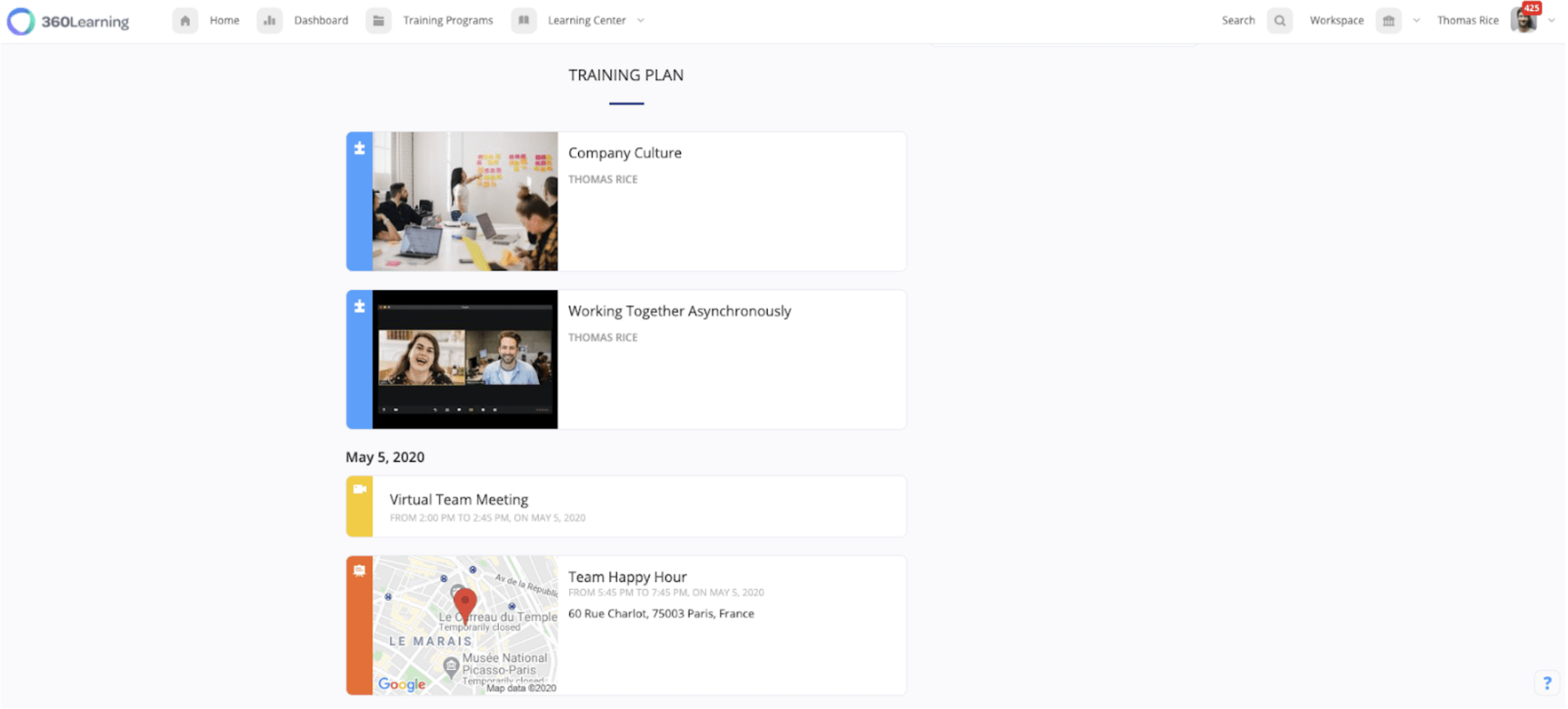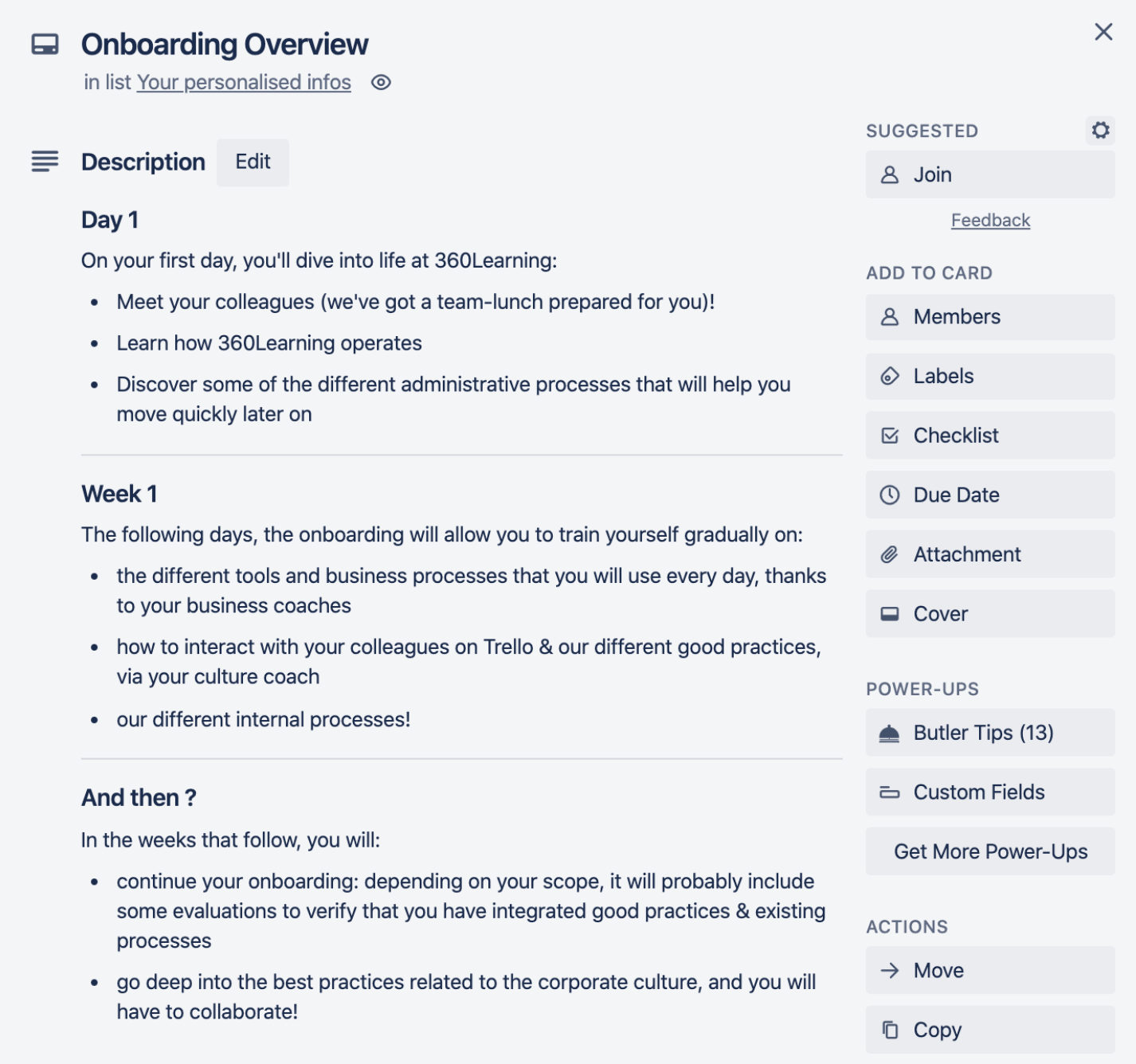Recruiting firm Jobvite found 33 percent of surveyed employees quit their jobs within the first 90 days. That’s a lot of turnover, especially considering how costly it is to train new recruits: 45% of HR estimates that over $10,000 a year is wasted on ineffective onboarding, according to BambooHR.
But it’s not all doom and gloom—when onboarding is done well, the results are impressive: A SHRM study found that 69 percent of employees who participated in a well-designed onboarding program were more likely to stay in their jobs for up to three years.
What can we conclude? Onboarding is a crucial factor in employee retention and recruitment ROI. This is especially true when hiring developers, where the competition is fierce and salaries, high. It’s essential to ace your onboarding, especially if it’s remote, (either because you’re hiring offshore or because of social distancing obligations.)
At 360Learning (a learning platform based on Collaborative Learning), we’ve done our fair share of virtual onboarding, especially of our new developers.
In this post, we share our recipe for successful remote onboarding, so you can get your new hires up and running in no time.
Onboarding: a 3-step process
The first rule of thumb is: don’t put the cart before the horse. Although there are many team-specific details to iron out for any new recruit, there are also processes, information, and tools that every single new joiner will need, no matter what their role. That’s why we break down the onboarding process into three phases:
- Preboarding
- Induction
- Role-specific onboarding
Preboarding
Preboarding happens before a new hire’s first day. It’s all the communications and exchanges before your new employee sets foot in your (virtual) office. This step is absolutely crucial to making the right first impression.
The focus is on smooth logistics and making sure the new hire has everything they need on Day 1, so they don’t get those first days of school jitters. Here’s an example of a program for a new hire’s first day on the 360Learning platform:
Here’s how we prep for preboarding at 360Learning:
- Preparing physical materials, including computer and welcome kit; for a remote onboarding program, it would mean sending this welcome kit and equipment by post.
- Setting up new hire profiles on our systems, e.g. email, learning platforms, and other tools and software used internally
- Reviewing learning paths and resources that will be shared with the new hire to ensure everything is complete and clear
- Planning and coordinating all communications (e.g. calendar invitations) between different internal stakeholders
- Scheduling time to introduce the new joiners directly to colleagues and team members with the help of onboarding activities.
- Establish clear channels for new joiners to provide feedback, and identify any areas of improvement in the pre-boarding process
Induction
Once the new joiner is in the door, it’s time for a two-day ‘induction’. This, again, is standardized for all new hires, whether they’re a developer or not. On the agenda is the following:
- An overall introduction and welcome
- A module on the importance of giving and receiving feedback through the onboarding process
- An introduction to our culture and organization
- The key tools new hires can be expected to use
Once preboarding and induction are over, it’s time to move on to the role-specific ramp-up. This is the meat and potatoes of onboarding, where new hires start to understand how they can add value and contribute specific expertise.
How 360Learning Virtually Onboards New Developers
When it comes to remotely onboarding new devs, we’ve distilled our experience into 8 actionable tips or steps you can apply at your company:
#1 Provide your onboarder with their own onboarding coach
Since our engineering team doesn’t have a layer of middle management, onboarding is left to individual contributors on the team. However, they don’t always have a lot of experience orienting new hires, and they may need some extra support. So, we provide the onboarder with their own resource to help, an ‘onboarding coach’.
They are there to provide support, guidance, and check-ins for the onboarder, to be sure they’re performing at their best and getting new hires ramped up and motivated.
#2 Create virtual social moments
It can be easy to forget how isolated your new hire might feel, joining 100% remotely. Just because your team isn’t together physically, doesn’t mean they shouldn’t get to know each other.
At 360Learning, we organize a virtual drink or meal together with the team in the first week or so. It helps break the ice and make the new hires feel welcome and part of a bigger community.
#3 Clearly outline career path expectations
Employees expect a new job to come with career development opportunities. The first few weeks or months are a chance for the company to assess the aptitude of a new employee, but also a chance for the new employee to suss out how much room they might have to grow at this new company.
Show new developers they won’t be stuck in the trenches forever. Outline your grid or process for promotions, career development, and progression within the team, or even across teams. Make sure new hires understand they’ll have the learning opportunities they need to keep up to date with changing technologies. This is something we do systematically when onboarding new engineers.
#4 Encourage new joiners to make new connections
Some new hires at 360Learning shy away from reaching out virtually. To help them break the ice and make new connections, we organize a round-robin drink with a new hire, their onboarder, and two guests (preferably from other teams).
Activity costs are reimbursed by the company, and the new hire ideally organizes the next meet-up, ‘forcing’ them to create new connections.
Here are just a few icebreaker ideas that can be done virtually:
- Skribbl.io
- Blind test video on YouTube
- Jackbox games
- Icebreaker questions
#5 Be as clear as possible as early as possible with feedback
Onboarding is a time for both employee and employer to decide if there’s a good fit. Timely and clear feedback goes a long way in creating a good assessment and avoiding surprises at the end of a probation period.
We make sure to provide regular opportunities for both onboarder and new hire to give and receive feedback on performance, align expectations, and ask or answer any questions.
#6 Set micro-goals you can use to assess a new joiner
At the end of a new joiner’s probation period, their manager (or coach) will need concrete ways to assess their performance and officially weigh in on whether they think it’s a good fit. If the new hire hasn’t been slowly ramping up their workload—and achieving small goals as they go—it will be difficult to conduct a reasonable probation review.
That’s why it’s essential for managers to set reasonable micro-goals early in a new hire’s schedule. You don’t have to overwhelm them from Day 1, but make sure you’ll have something to talk about during that review, and that you’ve been clear with expectations throughout.
#7 Give a ‘time to complete’ for each onboarding module
At 360Learning, our developers have a lot of onboarding courses to complete. We want to be sure they’re able to manage their time and not get lost or overwhelmed by the new material.
That’s why we’re sure to always include a ‘time to complete’ indication (median duration) for each course, as seen below. This helps everyone stay on track and manage their busy day as they go through their onboarding training asynchronously.
#8 Balance synchronous and asynchronous communication
At 360Learning, we’ve built a very strong company culture that we’ve baptized ‘Convexity.’ One of its guiding principles is the use of asynchronous communication. Basically, writing or documenting something instead of sharing it on a call or in-person.
This helps our teams stay focused, and also allows for another one of Convexity’s pillars—transparency—to shine.
While it may not make sense for all communication to happen asynchronously, especially for new hires with lots of questions, it’s a good idea to balance these two ways of sharing information (synchronous and asynchronous). For instance, we only have a free version of Slack to push communication onto our preferred tool, Trello. But it’s perfectly acceptable to arrange a video call through Zoom or its alternatives to go over a bug or coding question in person, if that’s going to get the job done, faster.
Invest in your onboarding process
Onboarding is a key part of the employee lifecycle. Especially when done virtually, it’s key to spend time, effort, and energy in making it a success for your new hires. You’ll see the impact on your employee retention rates.









